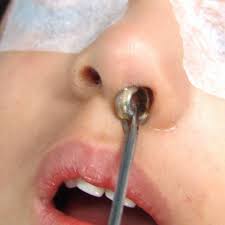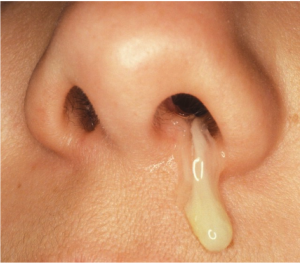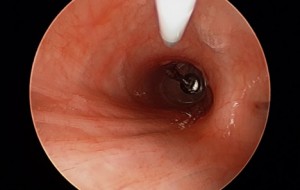Foreign object in the airway
Children six to three years old are most at risk to inhale foreign bodies.
In the nose: The removal of foreign bodies in the nose is usually simple with adequate visualization and appropriate instruments. Patient immobilization facilitates the removal of foreign body without complications, especially in children. Nasal decongestion, made with a topical vasoconstrictor agent (Otrivin), helps to reduce swelling of the mucous membrane, thus improving visualization. By cons, if the object is possibly a battery, the instillation of a solution, whatever it is, in the nostril is absolutely contraindicated because it could aggravate burns. One must always extract a battery in emergency to limit the damage. Flexible naso-pharyngoscopy may be necessary to find the object if lodged deeply. In addition, general anesthesia is sometimes inevitable.
A long-term foreign body in the nose causes an infection and a yellowish discharge only from the foreign body side.


Trachea or bronchi: When a foreign body is present in the airways, an endoscopy is used to confirm or reject the possibility, and then proceeds to the extraction of the object, if any. Laryngoscopy and bronchoscopy under general anesthesia should be taken without delay to reduce the risk of complications.

Reference: Le Médecin du Québec, Volume 42, Number 5, May 2007.
__________________________
Emergency in ENT
Peritonsillar abscess
Ludwig’s Angina
Foreign body in the ear
Foreign body in the respiratory tract (nose, trachea, bronchi)
Foreign body in the esophagus
Epiglottitis
Epistaxis
Perilymphatic fistula
Nose fracture
Hemorrhage post-adenotonsillectomy
Acute mastoiditis
Facial paralysis
Sudden hearing loss
